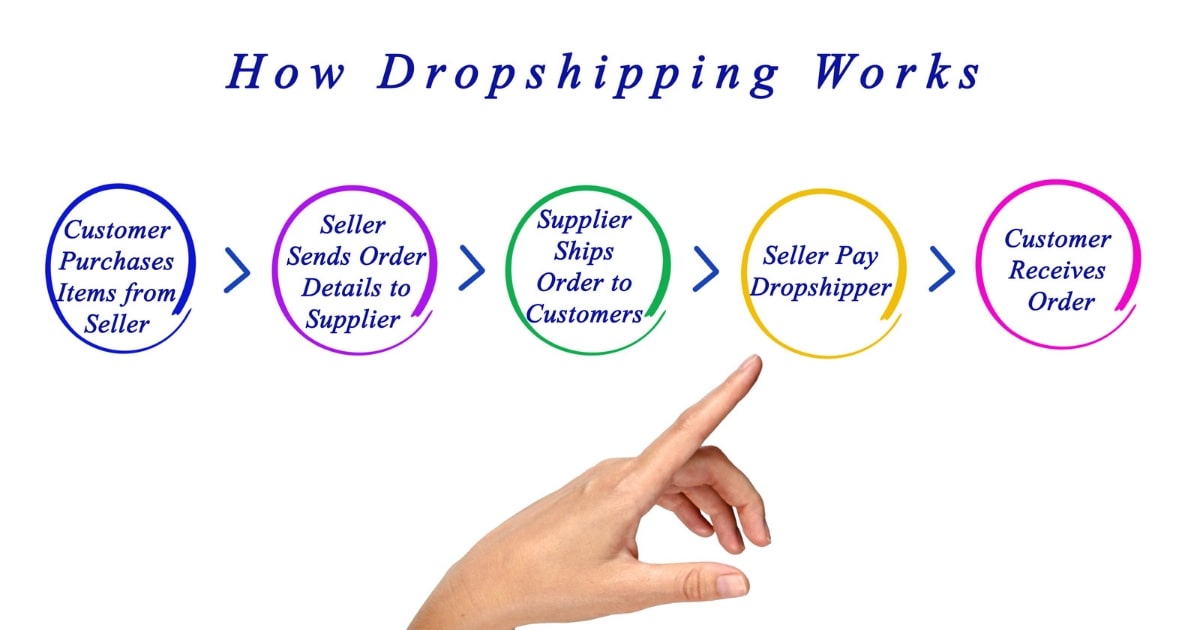While dropshipping is one of the fastest ways to start a business, it doesn’t guarantee easy money. It takes hard work to grow a dropshipping business and keep clients happy. There are many factors to consider that will define your dropshipping business’ success and possible failure.
To get you started, we have a step-by-step guide on starting a dropshipping business in the Philippines.

What Is Dropshipping And How Does It Work?
Dropshipping is a retail business where the owner doesn’t need to keep their items on hand. The dropshipper sells items on their online store or business page. When a customer purchases an item, the dropshipper sends the order to a third-party supplier. The supplier then ships the product directly to the customer. The dropshipper acts as a “middle man” between the customer and the supplier.
How Do You Earn In Dropshipping And Is It Profitable In The Philippines?
You earn by adding a profit margin to your products. The supplier will give you a price or their wholesale price, and then you can add a reasonable amount. This becomes your profit earnings. According to BigCommerce, ideally, your profit margin can be around 30%.
It’s a legit business that can earn huge earnings if done correctly. In the Philippines, e-commerce is a vast industry. While there’s a huge opportunity, there are also many competitors. If you want to succeed in dropshipping, you need to study running it efficiently.
Beginners Guide On How To Start A Dropshipping Business
1. Focus On Your Niche
So, you have decided to give a dropshipping business a try. First on your list to find your niche. Niche is a bit different from a target market.
While the target market is your ideal customers, a niche is your business’ possible area of specialty. Niche strategy focus on a unique target market. Instead of just looking at the general population as potential customers, niche strategy streamlines it to a specific demographic group that would benefit the most from your products.
For example, you want to sell beauty products to single moms. Your niche would be mompreneurs. This will help you identify the need that you want to answer.
Identifying your niche is crucial in starting a business. It will define the products you choose to sell, your price range, and how you want to market your products. Basically, your niche will help determine the success or failure of your business.
According to an article of Forbes, “Finding your niche is about determining the focus of your business and then working to hone your skillset or product. This helps you refine your offerings and build the expertise that gives you the legs to withstand the test of time.”
Many startups fail because they are not able to find their niche. They weren’t able to provide a solution to a problem of a specific group. If your focus is too broad, your business will be in danger of closing.
2. Make A Business Model
Successful entrepreneurs have said countless times that if you want to make it big, be prepared. If you want your business to succeed, you need to develop a solid business plan.
Basically, your dropshipping model is your plan to make a profit. When crafting a business plan, always plan based on a long-term commitment. Here are some things you can include in your dropshipping business model:
- What products should you sell? Identify the items your want to sell. Your items should answer a problem of your niche.
- Where will you get your supplies? These are your third-party suppliers. They should be reliable and efficient in delivering their services and products. We listed below a few platforms where you can look for suppliers.
- Who will buy your products? This is your identified niche that will support your business.
- What are the strengths of your business? Identify what will set your business apart from the rest.
- What are the limitations, threats, or dangers of your business? Identify the areas for improvement and work on them.
- Who are your competitors? Identify what your competitors are doing best and try to replicate and improve.
- Where do you sell your products? This is the e-commerce site where your will post your products. We have a list of sites you can consider below.
- How do you plan to sell your product? This is your niche marketing strategy. We have listed below a few ways to help market your products online.
- How much is your profit margin? The amount you add to the suppliers’ price. Ideally, this can be around 30 percent.
- How much are your overhead costs? The operational expenses you need to run your business. Be wary of additional fees such as delivery charges, etc.
- What additional expenses should you consider? Take note of other expenses that you may need to incur from time to time. These could be taxes, permits, etc.
Thanks to online trends, preparing your business model is now so much easier. There are even templates online you can use. Looking for trending items to sell is easy to do nowadays. You can go on TikTok, Facebook, or any social media platform to look. You can also go on Google Trends, Keywords Everywhere, or Shopify for a more reliable trend list.
3. Find Trusted And Reliable Suppliers.
After coming up with a business plan, you start filling up the important part of finding your suppliers. Since your business will rely heavily on a third party, finding credible and efficient suppliers is essential. Remember that if your supplier fails to deliver the right product and services, you will be held accountable for it.
You can look for suppliers on Chinese online platforms like AliExpress, Alibaba, and so many others. You can also look for wholesalers on Lazada or Shopee to make arrangements. Here are a few names and information on some wholesale suppliers you can consider:
AliExpress – The biggest dropship supplier in the Philippines from China. No signup or startup cost. It’s easy and convenient for newbies.
Alibaba – It’s an excellent platform for dropshippers because it offers a wide range of products. It’s possible to buy items for low prices and sell them for more to make a substantial profit.
Bangood – Headquartered in China, it doesn’t require a signup fee. It’s known as a very reliable and dropshipping-friendly marketplace.
DHGate Global – One of the most favored e-commerce platforms next to AliExpress.
Other platforms include China Brands, Woocomerce, Oberlo, and more.
When discussing the arrangements, remember to ask if the total amount already includes import tax and delivery charge.
Once you have identified your possible suppliers, evaluate them by ordering. See how their process works, their customer service, delivery time, and how efficient they deliver the agreements.

4. Build Your E-Commerce Store
Depending on your budget, you can build your e-commerce store on more than one site. Each site has its advantages and drawbacks, so studying and researching are crucial. Here are a few reviews of some popular platforms where you can build your e-commerce store:
Shopify – It’s a sleek and sophisticated platform that gives all the freedom to build your e-commerce site from the ground up. You can modify everything according to your liking. It’s also the most user-friendly site that will allow you to connect with many suppliers. However, it’s not free. Its basic package will cost you $29 or around P1,500 per month.
WooCommerce – You don’t need to pay to get a signup. However, you build your store on WordPress, and you need to pay for hosting. The good thing is hosting is relatively more affordable. After creating your store on WordPress, simply install the WooCommerce plugin.
Magento – While WooCommerce is targeted at small businesses, Magento is perfect for big businesses. It has higher costs but provides high security and high performance for your store.
Other more popular platforms include Lazada, Shoppee, Open Cart, and more.
5. Market Your Dropshipping Store
Now that you have set up your e-commerce store, you need to reach out to your customers. No matter how sleek your store is, you still won’t get sales if it doesn’t drive traffic. Let’s look at the different ways to drive customers to your store:
Search Engine Optimization (SEO)
SEO, also known as “Search Engine Optimization,” is a strategy that helps you get more organic traffic to your website by making your website more visible on search engines when people search for things like your products.
One tip to gain more organic traffic is using “gift-related phrases” as categories on your website. Instead of using jackets, pants, shirts, etc. Try to use “Best Father’s Day Gift Ideas.” Another tip is to have continuous blog content. Google likes content, so the more your website has new content, the more likely you’ll get ranked.
Social Media Activity
Social media has so much potential to drive traffic to your e-commerce store. In the Philippines, Facebook, TikTok, Twitter, Instagram, Kumu, Pinterest, and more hold so much power to make your products go viral.
Consider your talents and interests for each platform. After all, running a social media account takes time. To attract new customers, you must keep posting. So, if you’re unsure which app to use, start with the one that appeals to you the most.
Promos And Discounts
Filipinos love discounts and promos. If you can, offer creative and appealing promos and freebies from time to time until you build a solid and loyal following. Among the promotions you can try are free shipping, loyalty cards incentives, samples, flash sales, and many more.
Partner With Influencers
For most brands, partnering with influencers is a number one marketing strategy. Influencers on social media have hundreds of thousands or millions of followers. Influencer marketing is effective because they already earned an audience. The easiest way to partner with influencers is through paid posts on their social media accounts.
Collaborate With Other Brands Or Affiliates
Collaborating with other brands is an effective way to reach new customers because you can communicate with a new market. To do this, you can try working with other local businesses, join community groups, or partner with companies for promotions and events.
Paid Ads Through Facebook
One way to reach a vast audience is by creating an account with Facebook Ads Manager. Facebook advertisements are effective because you get to monitor your ad’s performance metrics. The cost of running a Facebook ad can vary, but it’s measured per cost per click (CPC) on an average of about $0.27 per click.
6. Grow Your Dropshipping Business
When it comes to growing your business, there’s no “one-size-fits-all” strategy. However, the basics remain the same, analyze and improve. Here are some tips to help you manage your dropshipping business effectively:
- Learn to study your site’s analytics and see what areas you can improve. You can look at which parts your customers are having troubles with and improve on your site. For example, if your check-out option is too confusing or your categories are difficult to understand.
- In managing a dropshipping business, you have to continually analyze your advertising or marketing strategy.
- Offer exceptional customer service. This may be a bit tricky since you will be working with a third-party supplier. But whenever you can, always be available to answer inquiries and requests. Reach out and have a good process of feedbacking. If a supplier messes up an order, own up the mistake and make it up to the customer by offering a solution.
- Study all the areas of a dropshipping business. Learn the intricacies of international shipping, additional rates and taxes, security and fraud issues, managing multiple suppliers, and more. All of these will take time, but learning them will be worth it.
Conclusion:
The best step to building a dropshipping business in the Philippines is to get started. Do your research, weigh your options, and then act on what you’ve learned. Learn what successful dropshipping business owners do. Despite your worries and reservations, take the risk.
- IT Engineer Quits Job To Sell Siomai, Now Earns P5,000 A Day - June 30, 2023
- From Chocolate Cakes To Noodles: Maricar Reyes’ Food Businesses - June 25, 2023
- How To Be A Cebuana Lhuillier Authorized Agent - June 17, 2023





